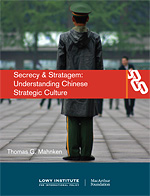Secrecy and stratagem: understanding Chinese strategic culture
To cope with a rising China, other powers will need a close understanding of Chinese strategic culture. This paper seeks to identify the enduring features of Chinese strategic culture, assess their role in Chinese policy and consider their implications for the future posture and responses of the People's Liberation Army. Drawing on ancient texts, modern official documents and accounts of Beijing's decision-making during crises, Secrecy and Stratagem raises important questions about the potentially risky relationship between Chinese strategic culture, misperception and miscalculation in Asia's uncertain security future.

- An analysis of Chinese strategic culture based on Chinese texts, strategic decision-making, and military deployments.
- The United States currently lacks a similar appreciation of the main tenets of Chinese strategic culture.
- The Chinese themselves see strategic culture as an important determinant of their behaviour and that of others.
Executive Summary
To have any hope of success, any strategy for dealing with China over the long term should be based upon an understanding both of the United States’ enduring strengths and weaknesses and those of China. These features should flow from sources that are immutable, such as geography, or that change slowly and predictably, such as culture or demography.
During the Cold War, the United States over time developed a good understanding of key features of Soviet strategic culture. These features, which included the imperative of defending the Russian Motherland (Rodina) from attack and a centralised style of command and control, served as the basis for strategy development and force modernisation. The United States currently lacks a similar appreciation of the main tenets of Chinese strategic culture. This paper presents an initial attempt to redress this gap. In particular, it seeks to understand the enduring features of Chinese strategic culture, develop indicators that could be used to validate whether these features are indeed operative and enduring, and explicate potential implications of these features for strategy development. It is based upon three types of evidence: (1) translations of both ancient Chinese texts on strategy, such as Sun Tzu’s The Art of War, and a sampling of modern official documents, such as the Chinese defence white papers and The Science of Military Strategy; (2) analyses of Chinese strategic culture by American, French, and Chinese scholars; and (3) other evidence, such as accounts of Chinese crisis decision-making and patterns of military deployments.

